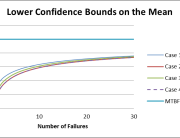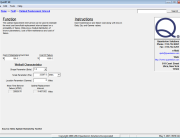A number of Reliability Modeling and Prediction techniques of varying complexity have been developed for different types of analyses. A Failure Modes, Effects and Criticality Analysis (FMECA), for example, is a bottom-up analysis of the system that assists in the identification of possible failure modes, and the subsequent effects on the system. A Fault Tree Analysis, on the other hand, is a top-down review of the possible event combinations that can precipitate an undesired, high-level event (e.g., loss of system power). These are commonly used techniques to evaluate the design of a system, and identify and eliminate single-point failures (e.g., the failure of a single component that can cause a complete system failure).
There are additional techniques like Reliability Block Diagrams (RBD) that model a system as a collection of blocks representing the subsystems and/or components of the system. The blocks are graphically connected in a manner that reflects the series and parallel relationships between these lower-level assemblies/subsystems. Using such diagrams, one can estimate the reliability of the system from the reliability of its “parts”. A more detailed discussion of the various system modeling techniques can be found in the Reliability Modeling RELease Guide.
To utilize these system-level models to predict a system’s reliability, one must first know (or predict) the reliability of the lower-level assemblies and specific parts/components. Several techniques can be used to perform these predictions, differing in complexity, input requirements and perceived accuracy. Some of the most common part/component reliability prediction techniques include:
- Statistical Data Analysis
- The availability of part/component failure data collected from testing, simulations and/or operational use typically lends itself to the traditional statistical data analysis approach. Using this technique, engineers attempt to match an appropriate statistical distribution (e.g., the Weibull distribution) to the dataset. Once the appropriate distribution is identified (i.e., the data matches the behavior of a specific distribution), analysts can predict/estimate a number of important reliability characteristic.
- Physics-of-Failure (PoF) Modeling
- This approach considers the various operational factors that affect the part/component’s predominant failure mechanisms (i.e., the most common types of failure). The developed models then predict the time to, or likelihood of, failure based on the underlying physics of the root failure mechanisms. However, based on the specificity of these models, there are many instances where a valid model may not be available.
- Empirical Approach
- In the absence of part-specific data, failure data from similar part-types or legacy components (i.e., surrogate data) used in similar operating conditions can provide a reasonable estimate of a part’s/component’s behavior.
- One might also use empirical prediction models, which adjust a base failure rate for a specific part-type with coefficients that quantify the impact of different operational stresses (e.g., part size, operating environment, loading, etc.) on a part/component’s likelihood of failure.
- Other Approaches
- Build and test, stress-strength interference analysis, modeling and simulation, etc.
Some of the most popular tools and publications for reliability prediction have been developed by the staff of the RMQSI Knowledge Center. For example, HDBK-217Plus(TM): 2015, the latest version of the electronic reliability prediction model handbook that replaced the industry’s MIL-HDBK-217, is a product offered exclusively by the RMQSI Knowledge Center. Our staff also developed multiple revisions of the Nonelectronic Parts Reliability Databook (NRPD 2016), the Electronics Part Reliability Databook (EPRD-2014) and the Failure Modes/Mechanisms Distributions (FMR-2013), three of the RMQ field’s most popular references for surrogate part/component reliability data.
The Reliability Prediction RELease Guide describes the differences between the various part- and system-level reliability techniques in greater detail, while the System Reliability Toolkit V provides a comprehensive, in-depth discussion on reliability modeling and prediction.



